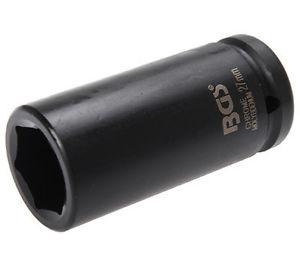

Use a strong 27mm deep socket for the crank bolt.
======
Hello all,
I am doing my first T-belt service, and am having a hell of a time getting
the crankshaft pulley bolt off. I am using a deep Craftsman 27mm
1/2"
drive socket, with a 4' cheater bar. I was just giving it the old
heave-ho, when I felt the special flywheel lock took break loose!
This
means I just turned my engine in the wrong direction (counter-clockwise)
just a little! YIKES! How bad is this?
It seems that the bolts used to hold the flywheel tool in place were a
little too short, and stripped out. It looks like I can put in some
longer
bolts to give it one more try.
Is this a typical problem, or am I doing something wrong? Is this
thing
reverse threaded?
Any suggestions would be greatly appreciated!
Thanks in advance.
Randy
===================
Randy Page wrote:
>
> Hello all,
>
> I am doing my first T-belt service, and am having a hell of a time getting the crankshaft pulley bolt off. I am using a deep Craftsman
27mm 1/2" drive socket, with a 4' cheater bar. I was just giving it the
old heave-ho, when I felt the special flywheel lock took break loose!
This means I just turned my engine in the wrong direction (counter-clockwise) just a little! YIKES! How bad is this?
Hi Randy,
Shouldn't be too bad if just a little. I would turn it a couple turns
the right way before proceeding.
>
> It seems that the bolts used to hold the flywheel tool in place were a little too short, and stripped out. It looks like I can put in
some longer bolts to give it one more try.
>
> Is this a typical problem, or am I doing something wrong?
My threads weren't very good either and I put longer bolts in. It
worked fin for me.
Is this thing reverse threaded?
Normal thread but very tight. I put a breaker bar with a socket on
horizontal and stood on the breaker bar. My 200 pounds at about 18
inches loosened it right up. Put it back on the same way.
Mark Grasser
=============
Hi Randy,
I just did this same thing this weekend on my '87. The bolts holding the
special tool are a little too short for that kind of torque. I used a much
longer bolt on the bottom and this turned out well. The bolt is not reverse
threaded, but when it is put in it is torqued to (I think) 215 ft/lbs. and
also, a lot of people use Loctite. This means, you probably need to apply
about 250 to 260 ft/lbs to loosen it.
Regards
Tom Csibor
===============
I'm doing my first timing belt job and got as far as "remove the
crankshaft
bolt". I have the flywheel tool installed and at about 800+ ft-lbs
with a
4 foot cheater I broke my heavy six point socket. Before I break something
else - is this a standard right hand thread?
Thanks,
Don McLeod
Silver 88 auto
==========
Dear Don:
Yes. Counterclockwise to take off. I was able to do
it with an impact wrench socket of the correct size.
I will not use any chromed sockets on anything needing
torque in excess of 150 lbs. YMMV.
Merry motoring, ~ Ed ~
===========
Just checking here, but after the flywheel lock is in (re: timing belt job), to loosen the crankshaft bolt apply 218+ foot pounds torque *counter-clockwise*, correct? Because the flywheel lock is in there is no danger that the counter clockwise rotation will damage the engine internally-- correct? Doing this timing belt job piecemeal. Space heater can keep me warm enough out there!
David Cmelik
81 5sp "moosgrunmetallic"
===========
Correct. It is a standard right hand thread. Standing in front of the car facing the engine compartment with the wrench handle pointing straight up you should move it to the left to loosen the crank bolt. Right to tighten. I have always used the fifth gear, parking brake method myself. Gotta get one of those flywheel locks...
Jay K.
===========
Correct. The only real danger in turning the engine backwards (counterclockwise as viewed from the front) is if the belt tension is too low, the belt can slip.
Wally Plumley
928 Specialists
==========
I did this by re-attaching the flywheel and then putting in a couple of
bolt on the flywheel. Put a long rod through those to hold the crank
still. It also help support the engine as you'll need a lot of torque to
get it off. It goes on to 295Nm so 400 or 500 may be needed to get it off.
Glen